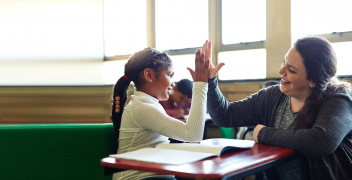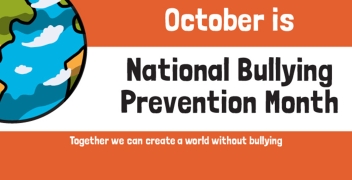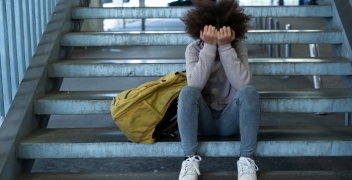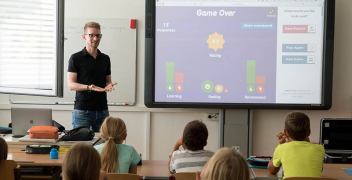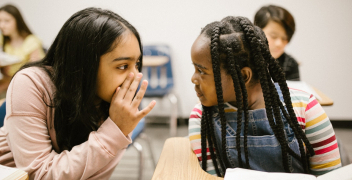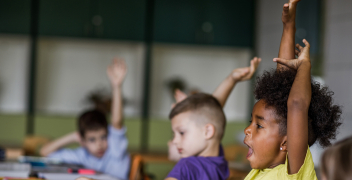Bullying in Schools
Although bullying is sometimes seen as “a part of growing up” or “kids being kids,” we now know that it can cause long-lasting harm to the youth who are targeted. Imagine a child who is picked on every day, whether physically, verbally, or through cyber-bullying. This chronic victimization can lead to a sense of hopelessness and poor self-worth that takes years to overcome.
Students need school to be a positive setting where they feel safe.
Consider Robert, a 10-year-old who is small for his age. When asked about some bruises on his face, he shares that every day on his walk home from school a group of older boys and girls taunt him, smack his head or push him down. He feels embarrassed and scared.
Or consider Aaliyah, a 13 year old girl who posts an online video of herself dancing and receives dozens of hostile and threatening comments. Then she finds out the video has been edited to make her look bad and shared with peers at school. She notices classmates are talking about her and avoiding her at lunch. She feels ashamed and alone.
Bullying is a common form of youth violence, particularly in school settings. As illustrated in the examples above, bullying is aggressive behavior (i.e., behavior that is intentional and mean) that occurs repeatedly over time and within the context of a power imbalance. While both bullying and general aggression are harmful, it is important to understand the difference. If two children of similar size, strength, or social status get into a one-time or occasional argument or fight, this is aggression, not bullying. What makes bullying especially harmful is that the targeted child feels helpless to stop it due to the unequal power dynamic. This is why it is extremely important for adults to intervene, provide guidance and support a target of bullying.
Bullying touches the lives of many school-aged children and adolescents, in part because imbalances in social or physical power are a frequent part of peer dynamics. Research shows that bullying increases in late childhood and peaks in early adolescence, specifically during middle school. It often takes place in unstructured settings such as the cafeteria, hallways, and playground during recess, where adult supervision is lower, but can occur in classrooms and supervised settings as well.
Students need a positive school climate, one where aggression and bullying are not tolerated and where they feel safe. When students feel safe, they are better able to concentrate, manage stress, and thrive academically, physically, and socially.
Fortunately, there are ways that students and school staff can take to prevent bullying and build more positive supportive school environments. Changing a culture of bullying and school violence requires more than just working with the children who bully and the targets, it needs a 'whole-school' approach. We need to equip students with the skills to be positive leaders, problem solvers, and active and caring bystanders of bullying. Creating a supportive and positive school climate depends on ongoing, coordinated action from everyone: students, school staff, families, and the wider community.
Click here to learn more about the power of a positive school climate.
Program Details
- Types of Bullying
To better understand how positive efforts can be made, it is important to understand the various types of bullying:
- Physical: Involves using physical force to control a peer. Behaviors can include hitting, kicking, punching, pushing and stealing or damaging someone's belongings.
- Verbal: Using words to harm others. This can include teasing, yelling insults, mocking, and threatening harm or violence. This can be done face-to-face or using electronic platforms, like a cell phone (e.g. texting).
- Relational: Involves the manipulation of social standing or reputations. Behaviors can include starting rumors, purposefully excluding someone from a group or social activities, encouraging others to ignore or reject someone and manipulating relationships to hurt or control someone. Click here to learn more about relational aggression.
- Cyber: Involves using electronic media, like social media, texts, or online games, to hurt others. This type of bullying can be especially harmful because the perpetrators can be more difficult to identify, it can be witnessed by larger audiences, and the digital evidence can be difficult or impossible to erase. Victims of cyber bullying are often also victims of in-person bullying, making the impact more harmful. Click here to learn more about cyberbullying.
Within a bullying situation, there are several key roles involved.
- The victim is the child who is targeted for bullying either by one child or a group of children. Certain sub-groups of children and adolescents may be at a higher risk for being bullied. Click here to learn more.
- The child who bullies has a power over the victim, whether the child is physically stronger, more popular, or more socially influential.
- Bully-victim is a child who at times chooses to bully others but is also a victim of bullying themselves. These children often face the greatest challenges, and these experiences can have a strong impact on their lives.
- Bystanders are the adults or other peers that witness the bullying event. They play a particularly important role either making the bullying continue (by laughing, watching, or forwarding a harmful text, for example) or helping to stop it.
- Facts and Statistics About Bullying in Schools
- In a 2022 survey of U.S. middle and high school students ages 12-18:
- One out of every five (19.2%) reported being bullied.
- 100% reported experiencing, witnessing (i.e. being a bystander), or being aware of acts of bullying during the school year.
- 26.1% of middle school students (grades 6-8) experienced bullying compared to 14.6% of high school students (grades 9-12).
- Among students who experienced bullying, the most common forms were spreading rumors (13%) and being made fun of or called names (11.9%).
- Students reported that being bullied had the most significant impacts on: their feelings about themselves (27.8%), their schoolwork (19.7%), relationships with family and friends (18.5%), physical health (13.4%).
- Surveys of cyberbullying in a nationally-representative sample of U.S. adolescents aged 13-17 show:
- The percentages of adolescents who have experienced cyberbullying in their lifetimes have more than doubled (18.8% to 54.6%) from 2007-2023, and continues to increase with 58% in 2025.
- In the past 30 days, cyberbullied adolescents reported their most common experiences were: excluded from a text or group chat (32.5%), mean or hurtful comments posted online (31.3%), being embarrassed or humiliated online (31.3%) and rumors spread online (29.2%).
- 80% of teens think bullying while playing video games is a problem for people their age.
- A survey of cyberbullying in tweens (ages 9-12):
- One in five report involvement in cyberbullying: perpetrating (3%), witnessing (15%), or being the target (15%).
- Of those who were cyberbullied, they reported it negatively impacted their: feelings about themselves (69.1%), friendships (31.9%), physical health (13.1%) and schoolwork (6.5%).
- In a 2022 survey of U.S. middle and high school students ages 12-18:
- Related CVP Programs
Recommended Resources
- Relevant Publications
- Fu R, Paskewich B, Randolph J, Bradshaw C, Waasdorp T. Parent Perceptions of School Relationships: Considerations of Racial-Ethnic Differences and Youth's Peer Victimization. Journal of Family Psychology. 2024.
- Waasdorp T, Doty J, Barlett C, Polanco C, Paskewich B, Leff S, Waasdorp T. Relational Peer Victimization as a Predictor of Academic Engagement. Journal of Child and Family Studies. 2023
- Mehari K, Beulah B, Paskewich B, Leff S, Waasdorp T. Cyberbullying and Empathy Among Late-Elementary School Children. International Journal of Bullying Prevention. 2023.
- Waasdorp T, Paskewich B, Waanders C, Fu R, Leff S. The Preventing Relational Aggression in Schools Everyday (PRAISE) Program: Adaptations to Overcome Subgroup Differences in Program Benefits. Prevention Science. 2022.
- Puhy C, Daly B, Leff S, Waasdorp T. Identifying Relationally Aggressive Students: How Aligned Are Teachers and Peers?. School Mental Health. 2022.
- Polanco C, Paskewich B, Leff S & Waasdorp T. Relational Peer Victimization as a Predictor of Academic Engagement. Journal of Child and Family Studies. 2022.
- Waasdorp T, Fu R, Perepezko A, & Bradshaw, C. The Role of Bullying-related Policies: Understanding How School Staff Respond to Bullying Situations. European Journal of Developmental Psychology. 2021.
- Waasdorp T., Mehari K, & Bradshaw, C. Anti-Bullying Programs in the USA and Canada. In The Wiley Blackwell Handbook of Bullying (pp. 490-509). 2021. https://doi.org/https://doi.org/10.1002/9781118482650.ch60
- Leff, SS., Waasdorp, TE., & Mehari, KR. An Updated Review of Existing Relational Aggression Programs. In S. M. Coyne & J. M. Ostrov (Eds.), The Development of Relational Aggression 2018, pp. 283-317: Oxford University Press.
- Waasdorp, TE., & Bradshaw, CP. Examining Variation in Adolescent Bystanders’ Responses to Bullying. School Psychology Review, 2018 Volume 47, No. 1, pp.18-33.
- Waasdorp, TE., Pas, ET., Zablotsky, B., & Bradshaw, CP. Ten-Year Trends in Bullying and Related Attitudes Among 4th- to 12th Graders. Pediatrics, 2017 Volume 139, No. 6, pp. 1-8.
- Leff SS, Waasdorp TE, Paskewich, BS. The Broader Impact of Friend to Friend (F2F): Effects on Teacher-student Relationships, Prosocial Behaviors, and Relationally and Physically Aggressive Behaviors. Behavior Modification. 2016;40(4):589-610.
- Leff SS, Paskewich BS, Waasdorp TE, Waanders C, Bevans KB, Jawad AF. Friend to Friend: A Randomized Trial for Urban African American Relationally Aggressive Girls. Psychology of Violence. 2015;5(4):433-443.
- Learn More
- Perspectives on addressing bullying in schools on the Research in Action blog
- Downloadable Tools from CHOP's Center for Violence Prevention
- Positive Behavioral Intervention and Support
- Centers for Disease Control and Prevention (CDC)
- Student Bullying: Overview of Research, Federal Initiatives, and Legal Issues (Congressional Research Service)
- Queen Bees and Wannabes: Helping Your Daughter Survive Cliques, Gossip, Boyfriends, and the New Realities of Girl World
- 'Masterminds and Wingmen': Preparing your son for the pitfalls of a boy's world
- Social Aggression Among Girls
- Collaborative for Academic, Social, and Emotional Learning (CASEL)
- StopBullying.gov
Watch this webinar for teachers and school staff about understanding the issue of bullying and how to prevent it:




